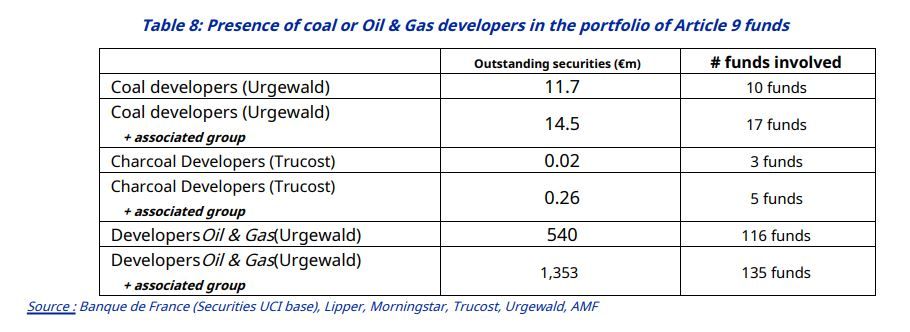There appears to be little difference between Article 8 and Article 6 French bond funds when it comes to their exposure to fossil fuels, French financial regulator the Autorité des marchés financiers (AMF) has found.
In a report published last week, the AMF looked at the Sustainable Finance Disclosure Regulation (SFDR) requirements of approximately 10,600 French funds and compared them with their exposure to fossil fuel industries.
As at the end of December 2021, a fifth of French funds claimed to fall under Article 8 and represented just under half of the cumulative net assets of French funds.
Just 2% of funds (220 funds) declared themselves as Article 9 funds and represented 3% of the total net assets of French funds.
And 79% of the funds are classified as Article 6 or undetermined, representing 50% of the cumulative net assets of French funds.
Coming into force in June 2021, SFDR aims to encourage the direction of capital towards sustainable activities by harmonising and strengthening transparency obligations in terms of sustainability in the financial services sector. The regulation also introduced a classification of financial products articulated around three categories defined according to the level of ambition displayed in environmental and social matters.
Coal exposure
The AMF’s report said it aimed to “find out whether funds that claim to promote environmental or social characteristics, or even that display a sustainable investment objective, are less exposed to the coal or oil and gas than the others”.
It continued: “If we focus first on equity funds, the results of the various estimates are globally consistent and seem to validate the hypothesis of greater exposure of Article 6 funds to the coal sector.”
But it said on the other hand, “the results on bond funds show that the difference in exposure between Article 8 funds and Article 6 funds is at best insignificant, and at worst frequently positive and significant.”
This depends, however, on which data source is used. Coal developers have very little presence in the portfolios of French funds, according to Trucost data, but Urgewald identified more of them.
“Regarding exposure to developers oil and gas (according to the Urgewald list), we again see that Article 8 funds are rarely significantly different from Article 6 equivalents,” the report said.
Moreover, it found counter-intuitively that exposure to the coal sector is substantially greater for Article 9 funds than for Article 8 funds, although it said this could be explained by the higher proportion of green, sustainable or social bonds, or sustainability-linked bonds in these funds, as these represent more than 80% of net assets in Article 9 funds.
Article 9
The report then looked at 219 Article 9 funds as at the end of 2021, corresponding to assets under management of €62bn, finding that 10 Article 9 funds were invested in coal developers as identified by Urgewald, representing aggregate financing of nearly €12m. However, the AMF noted that during 2022, certain funds were downgraded to Article 8, and exposures at the end of 2022 may have changed.
Regarding exposure to oil and gas developers, raw Urgewald data indicates that 116 Article 9 funds are exposed to €540m, and when parent companies are taken into account, this results in €1.35bn in funding through 135 funds.

In February, the regulator called for minimum environmental impact requirements for Article 8 or 9 funds, saying the latter should not invest in fossil fuels.
Its latest report concluded: “the differences between Article 8 and Article 6 funds are rarely significant in the statistical sense of the term, including when companies’ commitment to transition plans is taken into account.
“Therefore, the application of SFDR in its current state can create a gap between the expectations expressed by investors and the reality of practices, justifying the introduction of minimum criteria for financial products displaying ambitions in terms of sustainability.”








